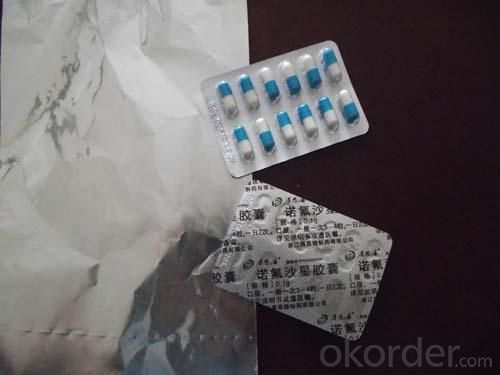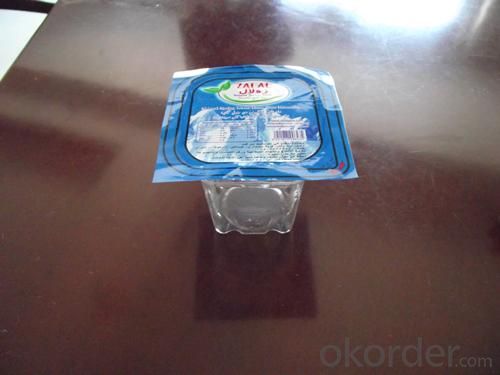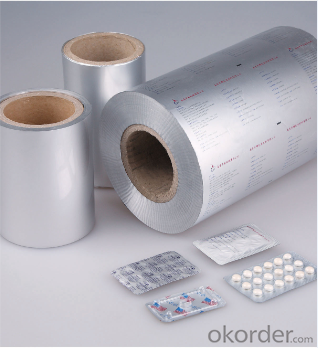PE/PET Aluminum Foil Induction Seal Liner for Pesticides Bottle Sealing
- Loading Port:
- Shanghai
- Payment Terms:
- TT OR LC
- Min Order Qty:
- 5 m.t.
- Supply Capability:
- 9000 m.t./month
OKorder Service Pledge
OKorder Financial Service
You Might Also Like
Item specifice
Product name: Induction seal liner for plastic and glass bottles
1. Introduction
Induction lining materials are one of the most important parts in packing industry for sealing the bottles and containers of the products for many reasons. And induction sealing is a simple and reliable method of bottle sealing. It welds an aluminum foil seal across the bottle neck.
2. Main specifications:
- Aluminum foil = 20-40 microns (0.02 - 0.03 mm)
- PE/PET/PP layer = 40-50 microns (0.04 - 0.05 mm)
- Seal backing material: pulp, foam, cardboard;
- Easy peel and non-easy peel seal available;
- Seal diameters are available from 10 mmto 180 mm;
- With different composition, liner thickness is various from 0.2mm to 1.2mm;
- It can be printed with custom logo, or embossed with any desired design;

3. Main benefits:
- Seals in freshness
- Prevent costly leaks
- Reduce the risk of tampering, pilferage, and contamination
- Extend shelf life
- Create hermetic seals
- Environment friendly
4. They can be used for sealing & packing in the different industries, including:
1- Motor, Engine, and Lubricant Oil products
2- Edible Oil products
3- Medicine products (Pharmaceutical factories for Tablet, Gel, Cream, Powders, Liquids, etc)
4- Food Products
5- Beverages, Fruit Juice, Butter, Honey, Mineral Water
6- Pesticides, Fertilizers, and Chemicals
7- Cosmetics
5. How to use:
Induction lining materials are constructed from aluminum foil membranes, coated with polymer and attached to a backing material by means of wax or polymer bond. This foil laminate is then placed inside a cap or closure, and the closure applied to the container, bringing the foil laminate into contact with mouth of the container.
The container then passes underneath the induction sealing head, where an electromagnetic field creates a low level of localized heat on the foil membrane, which is sufficient to melt both wax bond and polymer coating.
Soon after the container leaves area of the electromagnetic field, the polymer hardens, forming a flexible, yet hermetic seal between foil and neck of the container, while the backing material goes inside the cap as interior liner for more protection

6. Other information: heat induction foil liners
Name | bottle cap liner | MOQ | 100000 pieces |
Usage | This bottle cap liner is widely used in Pesticides, oil, chemical, food, medicine and other fields | Printing | 1-6 colorsprinting |
Specification | Thickness:0.1-0.3mm | ||
Shape | Round | ||
Features |
| ||
Application | bottle cap liner Is suitable for PVC,PET,PE,PP,PS ,PA,ABS ETC plastic bottles and glass bottles | ||
Min order: | 100000 pieces | ||
7. Why Choose Induction Sealing?
When properly applied, induction lined caps provide a hermetic, leak proof, and tamper evident seal. Using an induction sealing system is ideal for extending product shelf life, preserving freshness, preventing costly leaks and enhancing your product's value.

8. In order to quote you an accurate price, please kindly inform us the following information:
1.The diameter?
2.The thickness?
3.Whether printing? How many colors to be printed?
4.The material of the bottle, PE/PP/PVC/PS/GLASS or others?
5.The quantity you need?
- Q:I got nauseous the other day and that day one thing I ate was hamburger baked for 1 hour on aluminum foil with tomatoes mixed in. Is it possible the upset stomach was caused by the tomatoes reacting with the foil?
- I got sick from fried chicken that had been laying in foil all afternoon. It had a foil taste. yuk. I have baked macaroni and cheese before and covered it with foil, then the foil would start disintegrating. Not sure why that happened, but ewww.
- Q:What is the cost of aluminum sheets?
- The cost of aluminum sheets can vary depending on factors such as size, thickness, and quantity. It is best to check with suppliers or retailers for current pricing information.
- Q:you can turn in aluminum cans for cash some are called golden goats
- Aluminum okorder
- Q:Hi, I'm new here. Yoroshigu.I'm trying to make flash paper for magic tricks.To do that I have to make flash powder but in my location I can hardly find ingredients. Not to think about buying. Usually, I wait for a season and buy firecrackers. Then, I take the power and soak them into the paper and dry. This works but not so flash. Burned more likely.So, I wonder if I take aluminium oxide from aluminium oxide sandpaper and mix with powder from firecracker would produce a brighter flash than firecracker power alone?anyone know please share.
- Aluminum oxide is a ceramic. Ceramics are already, in their lowest energy state and won't give you the effect you're looking for: The sand (that's all aluminum oxide is) that you're adding will make your flash dimmer (and dirtier). You want to get some aluminum metal powder. It is very reactive, and will make your flash appear much brighter. You're on your own as far as the safety of this.
- Q:What are the different types of coatings available for aluminum sheets?
- Aluminum sheets come in various coatings, each with its own unique properties and advantages. 1. Anodized Coating: To create an anodized coating, the aluminum sheet is immersed in an electrolyte bath and an electric current is passed through it. This process forms a durable and corrosion-resistant oxide layer on the sheet's surface. Anodized coatings can be found in different colors and provide excellent resistance to abrasion. 2. Powder Coating: In powder coating, a dry powder is applied to the aluminum sheet and then heated to cure it. This method results in a durable, uniform, and visually appealing finish. Powder coatings are available in a wide range of colors and textures and exhibit excellent resistance to chipping, scratching, and UV fading. 3. Paint Coating: Liquid paint can be used to coat aluminum sheets, offering versatility in terms of color and finish options. Paint coatings provide good resistance against weathering, impacts, and chemicals, although they may not be as long-lasting as anodized or powder coatings. 4. Cladding: Cladding involves bonding a layer of a different metal, such as stainless steel or copper, to the surface of the aluminum sheet. This process enhances protection, improves aesthetic appeal, and enhances the sheet's mechanical properties. 5. Laminating: Laminating consists of bonding a protective layer, such as a film or sheet, to the surface of the aluminum sheet. This coating method offers protection against abrasion, UV rays, and chemicals, while also providing decorative finishes. 6. Organic Coating: Organic coatings, such as polyurethane or acrylic coatings, are applied to aluminum sheets to protect against corrosion, weathering, and chemical exposure. These coatings offer flexibility, good adhesion, and a wide array of color choices. The choice of coating for aluminum sheets depends on specific requirements, including durability, corrosion resistance, aesthetic appeal, and cost-effectiveness.
- Q:Can aluminum sheet be used for medical applications?
- Yes, aluminum sheet can be used for certain medical applications. It is commonly utilized in medical equipment, such as imaging machines, as it is lightweight, durable, and has good electrical conductivity. However, it is important to note that aluminum's use in direct contact with the human body or in implants is limited due to potential health concerns and the availability of more suitable materials.
- Q:What are the surface treatment requirements for aluminum sheets in the food industry?
- Aluminum sheets are widely used in the food industry due to their exceptional resistance to corrosion and lightweight nature. However, it is essential to fulfill specific surface treatment criteria to guarantee the safety and quality of the food items. To begin with, aluminum sheets utilized in the food industry must undergo a cleansing process to eliminate impurities and contaminants. This can be achieved through various methods, such as chemical, alkaline, or mechanical cleaning. The objective is to eradicate any potential sources of contamination that could adversely impact the taste, odor, or safety of the food. In addition, it is crucial to properly finish the surface of the aluminum sheets to prevent any interaction between the metal and the food. Anodizing is a highly favored surface treatment technique that forms a protective oxide layer on the aluminum surface. This layer not only enhances corrosion resistance but also acts as a barrier against the migration of aluminum ions into the food. Moreover, it is of utmost importance to ensure that the materials used for surface treatment are food-grade and compliant with relevant regulations. The food industry has implemented specific guidelines and standards to ensure the safety and suitability of materials that come into contact with food. Therefore, adherence to these standards is essential during the surface treatment process to prevent any potential health hazards or risks of contamination. Regular inspection and maintenance of the surface treatment are also necessary to ensure its long-lasting effectiveness. This involves monitoring the integrity of the protective layer, identifying any signs of wear or damage, and taking prompt corrective actions. To summarize, the requirements for surface treatment of aluminum sheets in the food industry encompass thorough cleansing, proper finishing, the use of food-grade materials, and regular maintenance. These measures are critical in ensuring the safety and quality of food products, as well as compliance with industry regulations and standards.
- Q:How do aluminum sheets perform in terms of machinability?
- Aluminum sheets are known for their excellent machinability. They can be easily cut, drilled, and shaped using various machining processes such as milling, turning, and drilling. Aluminum has a low melting point and is relatively soft, making it easier to work with compared to other materials like steel. Additionally, aluminum sheets have good chip control, which means they produce smaller and more manageable chips during machining. This reduces the risk of tool breakage and improves the overall efficiency of the machining process. Furthermore, aluminum sheets have good thermal conductivity, which helps dissipate heat generated during machining, preventing tool wear and prolonging tool life. Overall, aluminum sheets are highly machinable and widely used in various industries for their ease of machining and versatility.
- Q:What is the specific heat capacity of aluminum sheets?
- The specific heat capacity of aluminum sheets is approximately 0.897 J/g°C. This means that it requires 0.897 joules of energy to raise the temperature of 1 gram of aluminum by 1 degree Celsius. The specific heat capacity may vary slightly depending on the purity and specific alloy of the aluminum sheet, but this value is a good approximation for most common aluminum sheets.
- Q:I have to wire solar DC photovoltaic panels and have always used at least an 8 gauge wire. Recently, I installed a solar electric fence and they recommended special electric fence wire that can handle 10,000 volts. It looks aluminum. The fence techs told me copper is only rated for 600 volts. And the power will leak through the insulation. They also say copper will corrode and created insulated spots. Does this mean that aluminum doesn't corrode and is it superior to copper? Is is all a lobbying scam to force us to buy copper? Can I use the electric fence wire in my solar wiring?
- yes copper wire is better than almunium since coppe is very best conductor that that of almunium
1. Manufacturer Overview |
|
|---|---|
| Location | |
| Year Established | |
| Annual Output Value | |
| Main Markets | |
| Company Certifications | |
2. Manufacturer Certificates |
|
|---|---|
| a) Certification Name | |
| Range | |
| Reference | |
| Validity Period | |
3. Manufacturer Capability |
|
|---|---|
| a)Trade Capacity | |
| Nearest Port | |
| Export Percentage | |
| No.of Employees in Trade Department | |
| Language Spoken: | |
| b)Factory Information | |
| Factory Size: | |
| No. of Production Lines | |
| Contract Manufacturing | |
| Product Price Range | |
Send your message to us
PE/PET Aluminum Foil Induction Seal Liner for Pesticides Bottle Sealing
- Loading Port:
- Shanghai
- Payment Terms:
- TT OR LC
- Min Order Qty:
- 5 m.t.
- Supply Capability:
- 9000 m.t./month
OKorder Service Pledge
OKorder Financial Service
Similar products
New products
Hot products
Related keywords





























